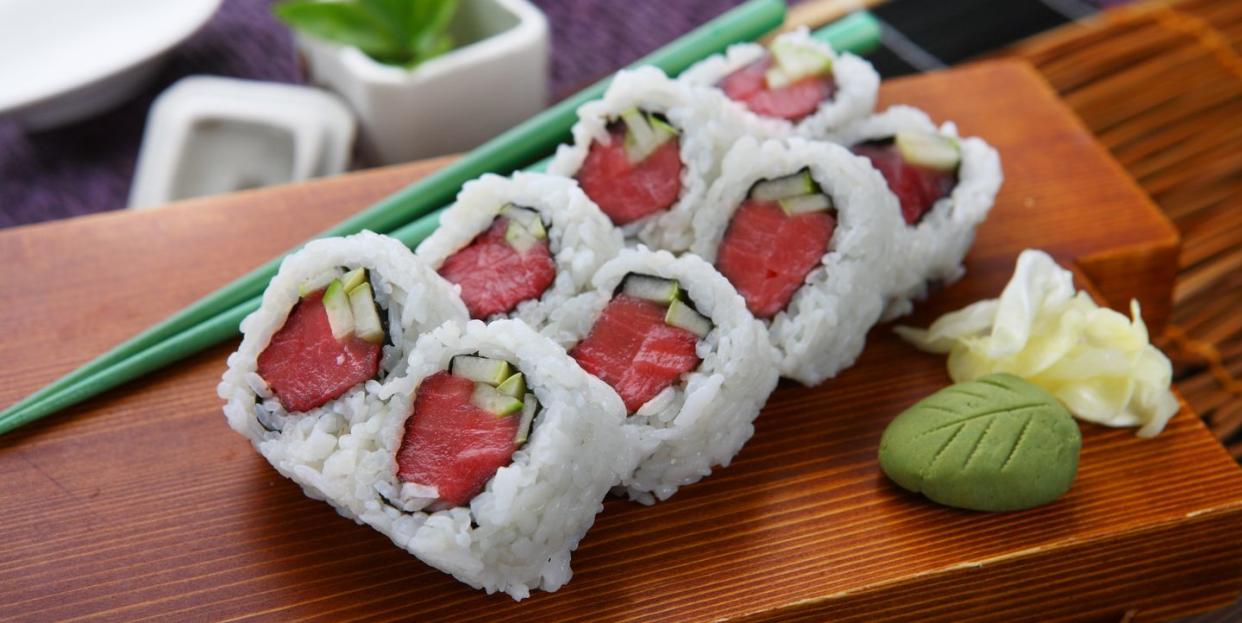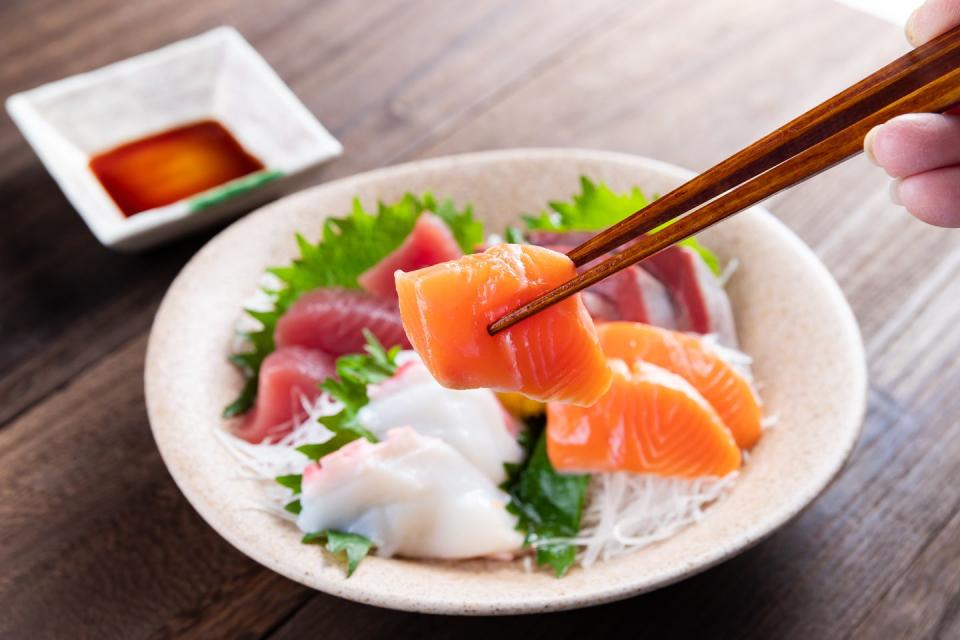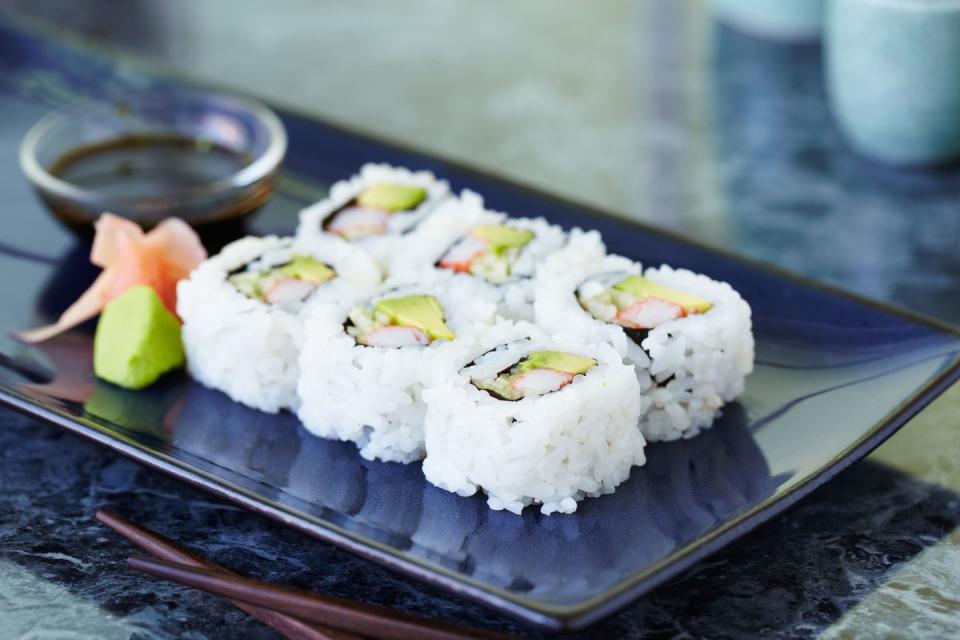How to Ensure Your Sushi Order Is Packed with Nutrition

When a craving for sushi hits, nothing else will satisfy in quite the same way. Whether your go-to order is a colorful platter of rainbow rolls, spicy tuna with a generous side of wasabi or a crunchy tempura roll, your sushi meal is bound to be full of both flavor and texture.
Delicious? No doubt. But is sushi healthy? To answer this, it’s helpful to consider the cuisine’s origins. Sushi — typically made with fish, vegetables, seaweed and rice — is Japanese in origin, which is particularly noteworthy because the average life expectancy in Japan is 85 years compared to the life expectancy of 77 years in the U.S. And though we can't guarantee that California rolls will help you live longer, as registered dietitians will explain below, there are many reasons why sushi is generally considered a healthy, nutrient-rich food.
What are the health benefits of sushi?
As with any food, registered dietitian Janice Chow, RD, says that whether or not something is healthy depends on someone’s individual health history and goals. “Using the word ‘healthy’ is tricky because it could mean different things for different people. It doesn't take into account individuals' health history, dietary patterns, culture, physical and mental sensations,” she says. Amy Yiu, RD, a registered dietitian with Health Stand Nutrition, agrees, saying that no food is “good” or “bad.”
With that in mind, generally speaking, both Chow and Yiu say that sushi is considered a healthy food. “Sushi is a wonderful food to have if it provides energy, pleasure and doesn't contradict with your health conditions or intolerances,” Chow says. There are many ways sushi benefits the entire body:

1. It’s full of heart- and brain-healthy omega-3 fatty acids
Fish or seafood is a core ingredient in most sushi dishes, and both dietitians say it’s a great source of omega-3 fatty acids. “There are many types of fish and seafood being used for sushi — for example, tuna, sweet shrimp, scallops and sea urchins,” Chow says. “A lot of them are rich in omega-3 fatty acids, which helps to reduce overall inflammation and risk of cardiovascular diseases.”
Yiu says that omega-3 fatty acids can’t be produced by the body, so it’s important to get them through food. In addition to supporting cardiovascular health, she explains that omega-3 fatty acids support brain health and also work to keep blood sugar levels steady.
Even if you don’t eat seafood or fish, Yiu says you can still get some great omega-3s by ordering sushi with avocado, which also has healthy fats. “Nori [seaweed] is also rich in plant-based omega-3 fatty acids, which could be beneficial for people who are vegetarians or vegans,” adds Chow.
2. Sushi can be satiating
Besides being a good source of omega-3 fatty acids, Yiu points out that the seafood and fish in sushi are also high in protein. This, she says, helps provide the body with energy. It’s also a key nutrient for satiety, a.k.a. feeling full and satisfied with your meal.
3. It’s good for your gut
Fiber is a key nutrient for digestive health, and, like omega-3s, are linked to supporting cardiovascular health and reducing inflammation. There are a few different ingredients in sushi that Yiu says add great fiber to your meal. One is veggies. Cucumber, shiitake mushrooms, carrots, bell pepper and avocado are all commonly used to make sushi. If you want to up the fiber in your meal even more, Yiu says to opt for brown rice over white rice, which is slightly higher in the nutrient.
The pickled ginger that often comes with sushi is another gut-healthy ingredient. “Pickled ginger is a fermented food so it offers probiotics, which could promote gut health,” Chow says.
4. Sushi is a good source of iron
According to Chow, the nori (seaweed) in sushi is rich in iron, yet another nutrient that supports cardiovascular health. In fact, nori is chock full of nutrients. “Nori is high in fiber, iron, calcium, iodine, vitamins A, B1, B2, C, D, E and K,” she says. Quite the resume, right? She explains that vitamins A, C and E are antioxidants, which support the heart and brain. “Iodine is a trace mineral which is vital to thyroid functions, while calcium and vitamin D are both good for bone health,” she adds.
Chow also says that nori isn’t the only sushi ingredient that has iron. The white rice does too. “There's nothing wrong if you prefer to eat white rice!” she says. “White rice is a great source of nutrients, including iron, B vitamins, manganese and simple carbohydrates.”
5. Sushi’s sides have anti-inflammatory benefits
Even the wasabi and pickled ginger that are often served with sushi have health benefits. As Chow previously explained, the pickled ginger is fermented, making it a gut-healthy food. But she also says that it’s rich in antioxidants. Both dietitians say that wasabi is full of antioxidants too. This is yet another way that sushi can support cardiovascular and brain health.
Clearly, sushi brings a lot to the table and most entrées are moderate in calories. A salmon and avocado roll (on average) contains 304 calories, 13 grams of protein, 5.8 grams of fiber, 42 grams of carbohydrates and 8.7 grams of fat per roll. California rolls have 255 calories, 9 grams of protein, 5.8 grams of fiber, 38 grams of carbs and 7 grams of fat per roll.
Sashimi (which is thin slices of fish served solo — no rice) is lower in calories. For example, buri (yellowtail) has 41 calories, 6.6 grams of protein and 1.5 grams of fat. However, since it is only the fish, sashimi does not contain fiber or carbohydrates so you may need to eat more to feel satiated.
Is there anything about sushi that isn’t healthy?

If you are eating sushi regularly, it’s important to be mindful of the mercury levels in the seafood and fish you’re consuming. Yiu says that, in general, the bigger the fish, the higher it tends to be in mercury. The fish highest in mercury include:
King mackerel
Marlin
Bigeye tuna
Swordfish
The vast majority of seafood and fish used in sushi is low in mercury, including salmon, shrimp, scallops, Atlantic mackerel and crab. “Considering the various mercury levels in fish, the Food and Drug Administration and Environmental Protection Agency declare that it's safe to consume 12 ounces of fish per week for adults. For those who are pregnant or breastfeeding, choose to consume fish that's low in mercury and [opt for] sushi that's fully cooked,” Chow says.
To ensure your sushi meal is as nutrient-rich as possible, pay attention to the condiments that come with your meal or that you may choose to add. For example, Yiu says that soy sauce can be high in sodium, something that people with high blood pressure should keep to a minimum. “Instead of dunking your sushi roll in the soy sauce, I recommend dipping the chopsticks in the soy sauce instead,” she says.
Preparation methods vary, but sushi rice is commonly made with vinegar and sugar regardless of whether it’s white or brown sushi rice. Diabetics or those watching their blood sugar may want to skip the rice and opt for a Naruto-style roll, which swaps out the rice for thin slices of cucumber instead.
If one of your health goals is weight loss, it’s also helpful to be mindful of mayonnaise-based sauces, which are often used in spicy rolls. These sauces are high in calories but low in nutrients. For example, a regular tuna roll is 194 calories, but a spicy tuna roll with mayonnaise-based sauce is 380 calories.
Tempura rolls are lightly battered and fried, which makes them higher in calories and less nutrient-rich than sushi that isn’t fried. This is something else to keep in mind if you want to enjoy sushi while also trying to lose weight.
The most nutrient-rich sushi orders

While both dietitians reiterate that all foods, including different types of sushi, can be part of an overall healthy diet in moderation, there are some guidelines to keep in mind if you are trying to order the most nutrient-rich options on the menu. Yiu recommends getting a salad as an appetizer to add extra fiber to your meal and then ordering any sauces you want with your sushi on the side. And she reiterates that if you are trying to get as much fiber as possible to go for brown rice instead of white rice.
“If you want a nutrient-rich sushi, consider sushi that includes all food groups like carbohydrates, protein, fat and fiber,” Chow says. Here are examples of popular menu items that put this into practice:
Alaska roll. Made with either raw or smoked salmon, avocado, cucumber, rice and nori, the Alaska roll hits on all of the nutrients Chow recommends aiming for. It often doesn’t need any sauce because the salmon is flavorful enough.
Salmon and avocado roll. A salmon and avocado pairing is healthy fats on healthy fats. Opt for brown rice if you want to up the fiber.
Tuna roll. To hit the carb-protein-fat-fiber foursome, go for tuna rolls that include a veggie, like cucumber. If you’re trying to lose weight, be mindful of the sauce that comes with spicy tuna rolls which is high in calories.
Rainbow roll. Rainbow rolls are made with multiple types of fish arranged on top — often tuna, salmon, yellowtail and more. Cucumber, avocado, crab, rice and nori complete the roll. There is such a wide range of nutrients packed into this roll that it’s a complete meal all on its own.
California roll. California rolls contain a combination of cucumber, crab (or imitation crab) and avocado and contain a healthy balance of carbs, fiber and healthy fats all rolled up together. Add a side of edamame to up the protein.
The bottom line:
Sushi checks all the boxes when it comes to a well-rounded meal. To make your order as healthy as possible, look for rolls with a balance of healthy fats, fiber and protein, and go easy on the condiments. With this in mind, when it comes to eating healthy, you’ll be on a roll.
You Might Also Like

